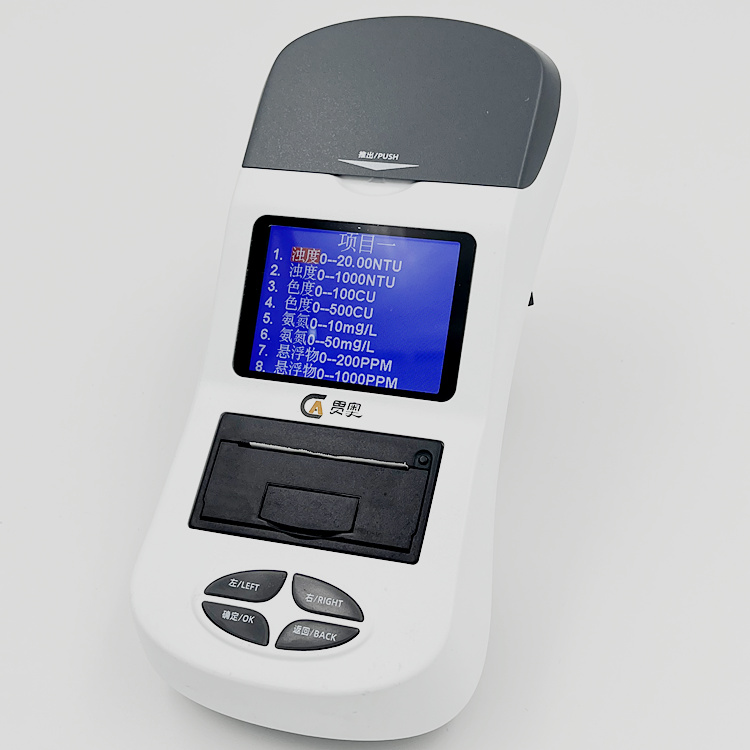通过使用五参数水质分析仪,我们可以快速准确地监测水体中这些关键参数的变化,帮助识别并处理水污染问题,以保护和维护水体的健康。这种仪器通常被用于监测自来水、河流、湖泊、池塘、地下水以及工业和农业废水等不同类型的水体。

The specific parameters of the five parameter water quality analyzer are as follows:
1. Dissolved oxygen (DO): Dissolved oxygen refers to the number of oxygen molecules dissolved in water and is an important parameter for measuring the survival of aquatic organisms and water health. The content of dissolved oxygen is influenced by factors such as water temperature, air pressure, water movement, and water nutritional status. The five parameter water quality analyzer calculates the concentration of dissolved oxygen by measuring the electrochemical reaction potential of oxygen.
2. PH value: pH value is an indicator of the acidity and alkalinity of a water body, reflecting the concentration of hydrogen ions (H+) in the water. The change in pH value can affect the ecological balance and life activities of water bodies, and has a significant impact on the growth and reproduction of aquatic organisms. The pH value can generally be determined by detecting the concentration of hydrogen ions in water using electrodes.
3. Conductivity: Conductivity is the ability of a water body to conduct current, which can reflect the concentration of dissolved ions, dissolved solids, and dissolved gases in the water. Conductivity is usually related to parameters such as salinity, turbidity, and temperature of water bodies. The five parameter water quality analyzer can measure conductivity by detecting the electrical resistivity in water bodies.
4. Turbidity: Turbidity refers to the content of insoluble particulate matter in water, including suspended particles, organic matter, bacteria, etc. The change of water turbidity is related to water pollution, nutrient content and biological ecological changes. Turbidity can generally be measured by detecting the concentration of particulate matter in water using the principle of light scattering.
5. Temperature: Temperature is an important parameter that affects the chemical and biological processes of water bodies, and has a significant impact on the ecology and environment of water bodies.
As a commonly used water quality analysis equipment, the five parameter water quality analyzer can be used in multiple industries:
1. Environmental monitoring industry: It can be used for water quality monitoring and evaluation of rivers, lakes, reservoirs, ponds and other water bodies, helping to monitor and manage environmental pollutant emissions and water quality, ensuring the safety and sustainable development of the water environment.
2. Drinking water industry: It can be used to detect the water quality of tap water and groundwater, monitor the content of harmful substances and microorganisms in the water, ensure the safety of drinking water, and ensure people's healthy drinking water needs.
3. Aquaculture industry: It can monitor the water quality of fish ponds, aquaculture ponds, and other water bodies to ensure appropriate water quality, promote the healthy development of aquatic ecosystems, and improve the yield and quality of aquaculture.
4. Industrial production industry: It can monitor the pollutant content in industrial production wastewater, ensure that wastewater discharge meets environmental requirements, prevent pollution to the environment, and protect the ecological environment.
5. Agricultural production industry: It can monitor the water quality of irrigation water and ponds in agricultural production, prevent pollution of water bodies caused by agricultural products such as pesticides and fertilizers, promote the healthy development of agricultural ecology, and improve the quality and safety of agricultural products.
Pay attention to the following points when using:
1. Operators should possess necessary skills and knowledge, be familiar with the usage methods and precautions of the instrument.
2. Analytical instruments should be regularly calibrated and maintained to ensure the accuracy and reliability of measurement results.
3. Before testing, necessary treatment should be carried out on the water sample, such as filtering and cooling, to ensure the authenticity and reliability of the test results.
4. During the sampling, storage, transportation, and testing process, relevant specifications and standards should be strictly followed to avoid pollution and errors.
5. When using analytical instruments, appropriate detection parameters and methods should be selected based on different detection purposes and requirements.
6. When detecting water bodies, attention should be paid to their fluidity and variability to avoid any impact on the detection results due to changes in water flow or water level.
In summary, the five parameter water quality analyzer has extensive application value in industries such as environmental protection, drinking water, aquaculture, industrial production, and agricultural production.



